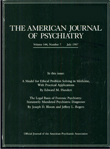Clinical and Methodological Factors Related to Reliability of the Best-Estimate Diagnostic Procedure
Abstract
OBJECTIVE: The reliability and accuracy of the best-estimate diagnostic procedure were examined, and factors associated with reliability were determined. METHOD: The subjects were 134 members of large multigenerational pedigrees densely affected by bipolar disorders or schizophrenia. Three best-estimate diagnoses were derived: first, by a research psychiatrist and research assistant unblind to the relatives' diagnoses; second, by two blind independent psychiatrists; third, by a panel of four blind psychiatrists. The subjects were characterized on several clinical and methodological variables, which were used to compare the agreements of two types of best-estimate diagnoses with the disagreements. RESULTS: There was satisfactory agreement between the unblind and blind consensus best-estimate diagnoses and between the two blind independent psychiatrists. Latent class analyses revealed that limited sensitivity was the main source of imperfect reliability. Confusability analyses revealed that the most problematic diagnostic distinctions involved schizoaffective disorder, which was confused with schizophrenia, bipolar I disorder, and schizophreniform disorder. Blindness significantly affected diagnostic outcome in latent class analyses. Moreover, for diagnostic disagreements, unblind diagnoses had greater continuity with the most predominant diagnosis in the pedigree than did blind diagnoses. Diagnostic disagreements were associated with the presence of mixed affective and psychotic symptoms, less diagnostic certainty, and shorter duration of illness. CONCLUSIONS: These results suggest that it is possible to identify cases that are more likely to lead to diagnostic disagreements in family and epidemiological studies and that blind diagnoses may help to prevent false positive diagnoses, which may be particularly detrimental to genetic linkage analyses. (Am J Psychiatry 1997; 154:1726–1733)



